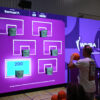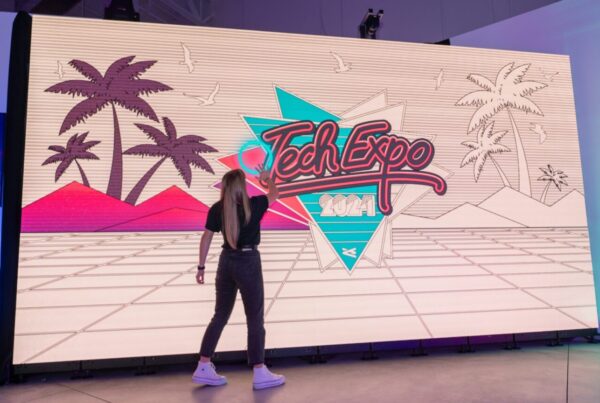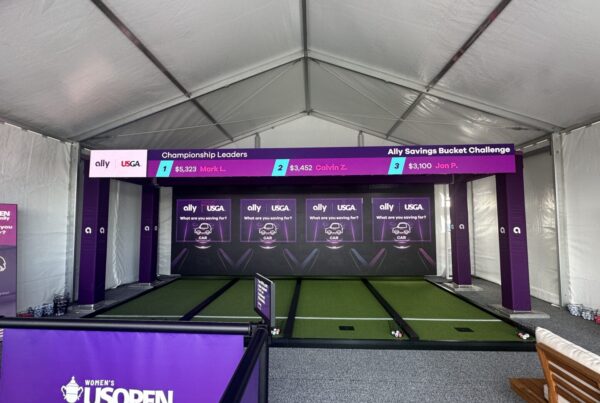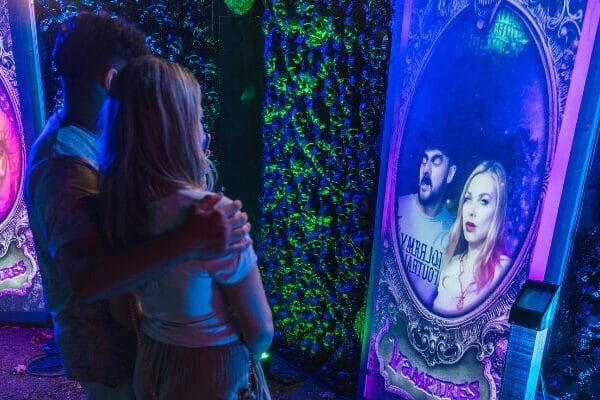Today’s consumers have seen it all. In a world of incessant noise and over-the-top marketing stunts, do you know how your brand is going to stand out from the crowd? Consumers don’t want to just look at products in stores anymore, they want to experience them. Delivering amazing brand experiences can drive consumers’ excitement for brands even if they’ve engaged with them multiple times.
At the intersection of customer experience, brand engagement, and technology lies 3D projection mapping, an innovative solution for retail brands looking to deliver incredible brand experiences to consumers. At its core, projection mapping refers to the process of projecting video and images onto 3D surfaces. To retailers, it means that any surface in your space, whether it’s a tennis shoe, couch, or wall, becomes an interactive screen that responds to consumer movements. With projection technology and video mapping, retail marketers can create 3D video animations for product launches, store displays, and more. The only limit is your imagination.
How Projection Mapping Works in Retail
As more and more consumer retail experiences move online, brick-and-mortar brands and retailers must find new ways to engage with customers and deliver unforgettable experiences. Projection mapping allows customers to engage with brands in ways they physically can’t anywhere else. While projection mapping is typically used in more apparel-type retail situations such as footwear, clothing, etc., it is readily available for all industries – if the creativity is there.
Brands are already relying heavily on graphics, videos, and heavy brand elements to create a memorable in-store experience. Projection mapping takes this a step further and delivers mind-blowing interactive displays that are truly unforgettable. For retailers, projection mapping also delivers an added layer of insights as it showcases exactly how customers actually think about and engage with your products. Because projection mapping technology all requires back-end laser projectors and some sort of home-base platform to actually trigger the projection, all of the customer data is stored and analyzed, allowing retailers the opportunity to go back and leverage the insights gained.
If your team is planning on introducing projection mapping into your retail strategy, here are some real-world best practices to serve as inspiration:
Deliver Immersive Experiences
If this is the first thought that came to mind when you read ‘projection mapping’ you’re not alone. Projection mapping technology is a perfect fit in the sportswear space, and Nike does show-stopping campaigns better than anyone. These NikeID studio displays in Niketown London show the power of consumer engagement. All the customer has to do is think of whatever they want, and the 3D display can show them exactly what this custom shoe will look like. It’s truly an unforgettable brand experience.
Enhance Retail Display Connectivity
Although it’s definitely tempting to go above and beyond with projection mapping, keep your customer and your surroundings top of mind while you’re planning your display. How do your customers engage with your products? How do they engage with your retail stores? This projection display campaign from L’Oreal shows that even if you’re working with a demure product and understated surroundings, you can still create something that connects with customers and catches the eye.
Combine Different Surfaces
While this Toyota commercial is a traditional piece of stunt advertising, the message it sends is pretty clear. The way the projection uses both the car, the street, and the wall creates a seamless viewing experience that makes the car seem larger than the sum of its parts. And, when it was over, the audience isn’t really remembering the car at all – they’re remembering the entire scene as a whole.
Don’t Stop at Opaque
Trust us, you don’t need a plain white wall to deliver an amazing brand experience. Take this new Lululemon store in Santana Row, San Jose. They put projection mapping displays inside the mirrors throughout the store that allows customers to engage with digital content in real-time as they themselves are trying on products. Talk about a win/win!
Go Big or Go Home
While your brand might be thinking about smaller, in-store ways to leverage projection mapping, don’t lose sight of the possibilities. Take a look at this example of projection mapping from Ralph Lauren, where a full-scale runway show was projected onto the side of a building in London. The mix of 3D elements from the building, live-action runway shots, and high-resolution images of products makes for a truly mesmerizing event. While your brand may be starting out small, there is only one way to go, and that’s up.
Whether you want video projections for your storefront displays or a unique visual experience for a product launch, contact the experts at Bluewater. We’ll work with you on the specific design, functionality, and technological needs of your projection mapping project.











